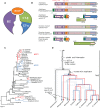Contrasting Patterns of Nucleotide Substitution Rates Provide Insight into Dynamic Evolution of Plastid and Mitochondrial Genomes of Geranium
- PMID: 28854633
- PMCID: PMC5570028
- DOI: 10.1093/gbe/evx124
Contrasting Patterns of Nucleotide Substitution Rates Provide Insight into Dynamic Evolution of Plastid and Mitochondrial Genomes of Geranium
Abstract
Geraniaceae have emerged as a model system for investigating the causes and consequences of variation in plastid and mitochondrial genomes. Incredible structural variation in plastid genomes (plastomes) and highly accelerated evolutionary rates have been reported in selected lineages and functional groups of genes in both plastomes and mitochondrial genomes (mitogenomes), and these phenomena have been implicated in cytonuclear incompatibility. Previous organelle genome studies have included limited sampling of Geranium, the largest genus in the family with over 400 species. This study reports on rates and patterns of nucleotide substitutions in plastomes and mitogenomes of 17 species of Geranium and representatives of other Geraniaceae. As detected across other angiosperms, substitution rates in the plastome are 3.5 times higher than the mitogenome in most Geranium. However, in the branch leading to Geranium brycei/Geranium incanum mitochondrial genes experienced significantly higher dN and dS than plastid genes, a pattern that has only been detected in one other angiosperm. Furthermore, rate accelerations differ in the two organelle genomes with plastomes having increased dN and mitogenomes with increased dS. In the Geranium phaeum/Geranium reflexum clade, duplicate copies of clpP and rpoA genes that experienced asymmetric rate divergence were detected in the single copy region of the plastome. In the case of rpoA, the branch leading to G. phaeum/G. reflexum experienced positive selection or relaxation of purifying selection. Finally, the evolution of acetyl-CoA carboxylase is unusual in Geraniaceae because it is only the second angiosperm family where both prokaryotic and eukaryotic ACCases functionally coexist in the plastid.
Keywords: accD; accelerated substitution rate; clpP; cytonuclear incompatibility; gene duplication; positive selection; rpoA.
© The Author 2017. Published by Oxford University Press on behalf of the Society for Molecular Biology and Evolution.
Figures





Similar articles
-
Rate accelerations in plastid and mitochondrial genomes of Cyperaceae occur in the same clades.Mol Phylogenet Evol. 2023 May;182:107760. doi: 10.1016/j.ympev.2023.107760. Epub 2023 Mar 13. Mol Phylogenet Evol. 2023. PMID: 36921696
-
Dynamic changes in the plastid and mitochondrial genomes of the angiosperm Corydalis pauciovulata (Papaveraceae).BMC Plant Biol. 2024 Apr 22;24(1):303. doi: 10.1186/s12870-024-05025-4. BMC Plant Biol. 2024. PMID: 38644497 Free PMC article.
-
Highly accelerated rates of genomic rearrangements and nucleotide substitutions in plastid genomes of Passiflora subgenus Decaloba.Mol Phylogenet Evol. 2019 Sep;138:53-64. doi: 10.1016/j.ympev.2019.05.030. Epub 2019 May 23. Mol Phylogenet Evol. 2019. PMID: 31129347
-
Invited Review Beyond parasitic convergence: unravelling the evolution of the organellar genomes in holoparasites.Ann Bot. 2023 Nov 30;132(5):909-928. doi: 10.1093/aob/mcad108. Ann Bot. 2023. PMID: 37503831 Free PMC article. Review.
-
Piece and parcel of gymnosperm organellar genomes.Planta. 2024 Jun 3;260(1):14. doi: 10.1007/s00425-024-04449-4. Planta. 2024. PMID: 38829418 Review.
Cited by
-
The complete chloroplast genome of Stauntonia chinensis and compared analysis revealed adaptive evolution of subfamily Lardizabaloideae species in China.BMC Genomics. 2021 Mar 6;22(1):161. doi: 10.1186/s12864-021-07484-7. BMC Genomics. 2021. PMID: 33676415 Free PMC article.
-
Reconfiguration of the plastid genome in Lamprocapnos spectabilis: IR boundary shifting, inversion, and intraspecific variation.Sci Rep. 2018 Sep 11;8(1):13568. doi: 10.1038/s41598-018-31938-w. Sci Rep. 2018. PMID: 30206286 Free PMC article.
-
Chloroplast Genomes and Comparative Analyses among Thirteen Taxa within Myrsinaceae s.str. Clade (Myrsinoideae, Primulaceae).Int J Mol Sci. 2019 Sep 13;20(18):4534. doi: 10.3390/ijms20184534. Int J Mol Sci. 2019. PMID: 31540236 Free PMC article.
-
Complete Mitochondrial Genome of Two Ectoparasitic Capsalids (Platyhelminthes: Monogenea: Monopisthocotylea): Gene Content, Composition, and Rearrangement.Genes (Basel). 2022 Aug 1;13(8):1376. doi: 10.3390/genes13081376. Genes (Basel). 2022. PMID: 36011287 Free PMC article.
-
Comparative Chloroplast Genomics at Low Taxonomic Levels: A Case Study Using Amphilophium (Bignonieae, Bignoniaceae).Front Plant Sci. 2019 Jun 19;10:796. doi: 10.3389/fpls.2019.00796. eCollection 2019. Front Plant Sci. 2019. PMID: 31275342 Free PMC article.
References
-
- Adams KL, Palmer JD.. 2003. Evolution of mitochondrial gene content: gene loss and transfer to the nucleus. Mol Phylogen Evol. 29:380–395. - PubMed
-
- Aedo C, Garmenia FM, Pando F.. 1998. World checklist of Geranium L. (Geraniaceae). Anal Jard Bot Madrid. 56:211–252.
-
- Bakker FT, Breman F, Merckx V.. 2006. DNA sequence evolution in fast evolving mitochondrial DNA nad1 exons in Geraniaceae and Plantaginaceae. Taxon 55:887–896.
Publication types
MeSH terms
LinkOut - more resources
Full Text Sources
Other Literature Sources
Research Materials

